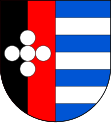Šťáhlavy
| Šťáhlavy | ||||
|---|---|---|---|---|
|
||||
| Basic data | ||||
| State : |
|
|||
| Region : | Plzeňský kraj | |||
| District : | Plzeň-město | |||
| Area : | 2397 ha | |||
| Geographic location : | 49 ° 40 ′ N , 13 ° 31 ′ E | |||
| Height: | 362 m nm | |||
| Residents : | 2,733 (Jan 1, 2019) | |||
| Postal code : | 332 03 - 332 04 | |||
| traffic | ||||
| Railway connection: | České Budějovice – Plzeň | |||
| structure | ||||
| Status: | local community | |||
| Districts: | 2 | |||
| administration | ||||
| Mayor : | Václav Štětina (status: 2007) | |||
| Address: | Masarykova 169 332 03 Šťáhlavy |
|||
| Municipality number: | 558427 | |||
| Website : | cassiopeia.gc-system.cz/stahlavy.cz | |||
Šťáhlavy (German Stiahlau ) is a municipality with 2186 inhabitants in the Czech Republic . It is located 14 kilometers southeast of the city center of Pilsen on the Úslava and belongs to the Okres Plzeň-město . The cadastral area is 2397 ha.
geography
The place is located at 362 m above sea level. M. on the left bank of the Úslava between the Pilsen Hills and the Brdy Forest . To the northwest of it rises the 560 m high cone of Radyně with the castle Radyně ( Karlskrone ). On the opposite eastern bank of the river, on the edge of the extensive forest areas of the Brdy, is the Kozel Castle . The railway line from Pilsen to České Budějovice runs through the village .
Neighboring towns are Starý Plzenec , Sedlec and Lhůta in the north, Bambousek and Kozel in the east, Šťáhlavice, Nezvěstice and Nezbavětice in the south and Bambousek and Losiná in the west.
history
The first written mention of Šťáhlavy comes from the year 1239, when Wenceslas I gave the village to the St. Lawrence Church of the Pilsen Castle in exchange for the settlements Stříbro and Benešovice . When the new city of Pilsen was founded, Šťáhlavy came under their rule in 1295 and from 1318 a separate manor was established, to which the villages of Lhůta, Kamýk and Neslívy were added.
In the middle of the 15th century, the manor came to the Duppau of Duppau . Their Stiahlau line, which built a fortress in the village, sold Stiahlau in 1539, including the villages of Šťáhlavice, Nezbavětice, Sedlec, Lhota, Neslívy, Nezvěstice, Žákava and Nevid as well as the desert castle Lopata to Jiřík Kokořovec from Kokořov. In 1561 he acquired the villages of Radyně, Prádlo and Plzenec from Zdenko von Sternberg . His son Karel Kokořovec built a renaissance castle on the village square . The castle chapel of St. Adalbert was also built during this time. 1624 was an inheritance division of the rule between Jiří Petr and Kryštof Karel Kokořovec. Jiří Petr received Šťáhlavy, Plzenec, Lhota, Sedlec, Šťáhlavice, Raková , Nevid and Nezbavětice. The Nebillau share went to his brother .
In 1710 Antonia Josephine Czernin von Chudenitz acquired the property around Šťáhlavy from Jan Jindřich Kokořovec and five years later the Nebillauer part. Šťáhlavy became the seat of the reunited rule. The next owner was Hermann Jakob Czernin, who in 1762 expanded the Adalbert Chapel into a church with three domes and in 1782 had the baroque south wing added to the palace. After Hermann Jakobs death in 1784 his son, the royal court hunter Jan Vojtěch Czernin (* 1745) inherited the rule, who in the same year began building the magnificent hunting lodge Waldschloss in the Brdywald below the hill Bor in the Úslavatal . In 1789 the castle was completed. The village school opened in 1794. At that time Stiahlau had become one of the largest domains in Western Bohemia, to which 50 villages and hamlets belonged. In 1797 the village had 810 inhabitants. Under Jan Vojtěch Czernin, the church was elevated to parish church in 1813 and the ruined Nebílovy Castle was rebuilt . In 1816 he died without heirs, so that his possession fell to Christian von Waldstein from the Wartenberg line of the family. After the replacement of patrimonial Stiahlau became an independent municipality in the Rokitzaner district on June 3, 1850. The former manorial rule has since been divided between the three judicial districts of Pilsen, Blowitz and Rokitzan .
At the end of the Second World War, American troops occupied the village on May 7, 1945. During the territorial reform of 1947, Šťáhlavy was incorporated from the Okres Rokycany into the Okres Plzeň-venkov and finally in 1960 with the incorporation of Šťáhlavice and Nezbavětice into the newly created Okres Plzeň-jih . From January 1, 2007 Šťáhlavy belongs to the Okres Plzeň-město.
The final resting place of the painter Jaroslav Špillar is in Šťáhlavy .
Community structure
The municipality of Šťáhlavy includes the district Šsteiláhlavice ( Stiahlawitz ). The Bambousek holiday complex, Kozel Castle and the Hájek forester's lodge are still located in the municipality.
Attractions
- St. Adalbert's Church, built as a palace chapel, redesigned in 1762 into a baroque church with three domes
- Šťáhlavy Castle, built around 1600 as a renaissance castle
- Kozel Castle
- Kornatický potok valley in the Brdy Uplands with the Lopata castle ruins
Personalities
- Gustav Eim (1849–1897), Czech journalist and politician, born in Štáhlavy
- František Xaver Franc (1838–1910), archaeologist, worked as a gardener at Kozel Castle
Web links
Individual evidence
- ↑ Český statistický úřad - The population of the Czech municipalities as of January 1, 2019 (PDF; 7.4 MiB)

